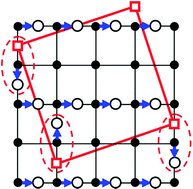High-TC superconductivity: a solid state chemistry model†
Abstract
We develop here a tentative explanation of the high-TC superconductivity mechanism, on the basis of solid state chemistry principles as well as some ancient ideas of Mott and Little. This is a real-space, non-retarded strong coupling model for the underdoped cuprate system. It develops the idea of a stabilized exciton phase formed during a Mott–Hubbard transition. Interactions between electric dipoles, as well as between doping charge and dipoles, bring the stability to achieve oxygen to copper charge transfer and hole pairing. We assume that, in order to minimize hole–hole Coulomb repulsion which increases strongly with doping, a hole ordering of 2D Wigner crystallisation-type favours the Bose–Einstein condensation and the superconducting state. We also discuss the specific role of copper and that of non-bonding electrons towards phonons when hole doping increases: instantaneous electric bond polarization, as for London's atomic forces, and soliton-type excitations allow the charge pairing which could be described thus in the scope of the BCS theory. This model is consistent with the main experimental and recent results characterizing the high-TC cuprates (phase diagram, oxygen holes, Fermi surface and superconducting gap symmetry, isotope effect, heterogeneity…).


 Please wait while we load your content...
Please wait while we load your content...